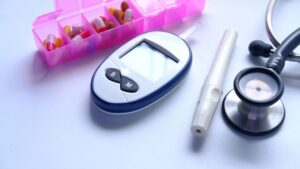When managing high blood sugar, understanding the role of medication is pivotal. High blood sugar, or hyperglycemia, is a common concern for individuals with diabetes, and if left unchecked, it can lead to a host of complications. This comprehensive guide is designed to illuminate the various medications for high blood sugar available, providing clarity and direction. From the mechanisms of action to the benefits and considerations of each medication type, we aim to empower you with the knowledge needed to make informed decisions in collaboration with your healthcare provider.
Contents
What Are The Best Medications For High Blood Sugar?
Managing high blood sugar, especially in the context of diabetes, involves a variety of medications, each tailored to meet the unique needs of individuals based on their health status, type of diabetes, and response to treatment. Below are some of the most commonly prescribed categories of medications for high blood sugar, with examples within each category:
Insulin
 Insulin therapy is pivotal for all individuals with type 1 diabetes and many with advanced type 2 diabetes. It mimics the body’s natural insulin production, facilitating the uptake of glucose by cells for energy, thus lowering blood glucose levels. Insulin types vary by onset, peak time, and duration of action, allowing for tailored regimens:
Insulin therapy is pivotal for all individuals with type 1 diabetes and many with advanced type 2 diabetes. It mimics the body’s natural insulin production, facilitating the uptake of glucose by cells for energy, thus lowering blood glucose levels. Insulin types vary by onset, peak time, and duration of action, allowing for tailored regimens:
- Rapid-acting insulin starts working within minutes and is ideal for controlling blood sugar spikes during meals.
- Short-acting insulin has a slightly longer onset and is typically taken before meals.
- Intermediate-acting insulin covers insulin needs for about half the day or overnight, acting as a baseline insulin.
- Long-acting insulin provides a steady level of insulin throughout the day and night, with no peak, mimicking the body’s natural basal insulin secretion.
Metformin
Metformin is the cornerstone of type 2 diabetes treatment, recommended as the first-line medication. It uniquely addresses the liver’s overproduction of glucose and enhances muscle cells’ sensitivity to insulin. Thereby facilitating glucose absorption without directly increasing insulin secretion. This mechanism reduces the risk of hypoglycemia, a common side effect of other diabetes medications. Additionally, metformin has benefits for weight management and may reduce the risk of cardiovascular disease.
Sulfonylureas
Sulfonylureas work by directly stimulating the beta cells of the pancreas to release more insulin, thus lowering blood sugar levels. These drugs have been used for decades and can be highly effective in controlling blood glucose. However, because they increase insulin production, they can raise the risk of hypoglycemia, especially if meals are skipped or delayed. They may also contribute to weight gain, which is a consideration in the overall management of diabetes.
Meglitinides
Meglitinides, like sulfonylureas, prompt the pancreas to produce more insulin. Their rapid onset and short duration of action make them particularly useful for managing blood sugar spikes that occur immediately after meals. This class of medications allows for flexible dosing around meal times but, like sulfonylureas, carries a risk of hypoglycemia and weight gain.
Thiazolidinediones
Thiazolidinediones work by increasing the body’s sensitivity to insulin, enabling more effective glucose uptake by the cells and reducing glucose production by the liver. These medications can be effective in lowering blood glucose levels but are associated with some serious side effects, including risk of heart failure, fractures, and weight gain. Therefore, they require careful patient selection and monitoring.
DPP-4 Inhibitors
DPP-4 inhibitors help to increase insulin secretion in response to meals and decrease the liver’s glucose production. These medications have a modest effect on lowering blood sugar levels and are less likely to cause hypoglycemia since their action is glucose-dependent. They are often used in combination with other medications, providing an added benefit without significant side effects.
GLP-1 Receptor Agonists
GLP-1 receptor agonists mimic the incretin hormone. This is naturally produced in the gut in response to food intake. These drugs enhance insulin secretion, suppress glucagon release, and slow gastric emptying, leading to a decrease in blood sugar levels. Additionally, they have been shown to promote weight loss and may have cardiovascular benefits. They are administered via injection. This might be a drawback for some patients.
SGLT2 Inhibitors
SGLT2 inhibitors prevent the kidneys from reabsorbing glucose back into the bloodstream, facilitating its excretion through urine. This unique mechanism can effectively lower blood sugar levels while offering additional benefits such as weight loss and blood pressure reduction. There is also evidence to suggest cardiovascular and renal protective effects. However, they can increase the risk of urinary tract infections and diabetic ketoacidosis, necessitating careful patient selection and monitoring.
Overall, the landscape of medications for managing high blood sugar is diverse, with each class of drugs offering unique benefits and considerations. The choice of medication(s) depends on a variety of factors, including individual health status, diabetes type, and personal preferences.
What Medication Is Used To Immediately Lower Blood Sugar Levels?
 In emergencies where blood sugar levels need to be lowered immediately, Rapid-acting insulin is often the medication of choice. Rapid-acting insulin starts to work within minutes of injection, making it highly effective for quickly reducing high blood sugar levels. Examples of rapid-acting insulins include:
In emergencies where blood sugar levels need to be lowered immediately, Rapid-acting insulin is often the medication of choice. Rapid-acting insulin starts to work within minutes of injection, making it highly effective for quickly reducing high blood sugar levels. Examples of rapid-acting insulins include:
- Insulin Lispro (Humalog)
- Insulin Aspart (NovoLog, Fiasp)
- Insulin Glulisine (Apidra)
These insulins can start to lower blood sugar within 15 minutes after injection, peak in about 1 hour, and continue to work for 2 to 4 hours. This makes them particularly useful for managing blood sugar spikes that occur during meals or sudden episodes of hyperglycemia.
For individuals with diabetes, particularly those with Type 1 diabetes or those with Type 2 diabetes who require insulin, rapid-acting insulin is a critical component of their diabetes management plan. It is used not only for emergency reduction of high blood sugar but also as part of a daily regimen to control blood glucose levels. It is often in conjunction with longer-acting insulin formulations.
Benefits And Risks Of Medications For High Blood Sugar
Managing high blood sugar with medications is a balancing act that involves weighing the benefits against the potential risks. Let’s discuss both in detail:
Benefits
- Improved Blood Sugar Control: Medications can help keep blood sugar levels closer to normal, reducing the symptoms of high blood sugar and improving overall well-being.
- Reduced Risk of Complications: By maintaining blood glucose levels within a target range, medications can significantly lower the risk of long-term complications associated with diabetes, such as heart disease, kidney damage, nerve damage, and eye problems.
- Enhanced Quality of Life: Effective management of blood sugar can lead to increased energy levels, improved mood, and a better quality of life.
- Flexibility in Diet and Lifestyle: While not a substitute for a healthy diet and regular exercise, medications can provide more flexibility in managing diabetes.
Risks and Side Effects

- Hypoglycemia (Low Blood Sugar): Some diabetes medications, especially insulin and sulfonylureas, can cause blood sugar levels to drop too low, leading to hypoglycemia, which can be dangerous if not treated promptly.
- Weight Gain: Certain medications, including insulin, sulfonylureas, and thiazolidinediones, can lead to weight gain. This can complicate diabetes management.
- Gastrointestinal Issues: Medications such as metformin and GLP-1 receptor agonists can cause gastrointestinal side effects, including nausea, vomiting, diarrhea, and abdominal pain.
- Risk of Heart Failure: Some medications, particularly thiazolidinediones, have been associated with an increased risk of heart failure in susceptible individuals.
- Increased Risk of Infections: SGLT2 inhibitors can increase the risk of genital and urinary tract infections.
- Potential for Long-Term Side Effects: Long-term use of some diabetes medications may have unknown effects, necessitating ongoing research and monitoring.
Given these benefits and risks, it’s essential for individuals taking medications for high blood sugar to work closely with their healthcare providers. Regular monitoring of blood sugar levels, along with periodic reviews of the medication regimen, can help manage the risks while maximizing the benefits.
Conclusion
In conclusion, medications for high blood sugar play a crucial role in improving the lives of those with diabetes by maintaining blood glucose at healthy levels, reducing the risk of serious complications, and enhancing overall quality of life. While these medications offer significant benefits, it’s important to be mindful of their potential risks and side effects.
By working closely with healthcare providers and regularly monitoring blood sugar levels, individuals can effectively navigate the challenges of diabetes management. Ultimately, making informed decisions that support their health and well-being. Do you want to get rid of diabetes? Join our online diabetes treatment program and reverse Diabetes naturally through lifestyle changes such as a Personalized Diet plan, Exercise, Yoga, dieticians, and health coaches.

